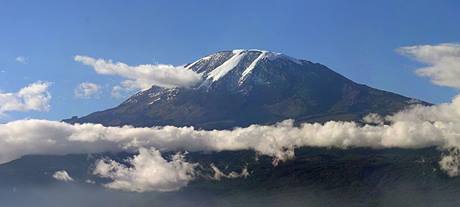Mount Kilimanjaro, Tanzania

Mount Kilimanjaro, in northern Tanzania, is the largest of 20 volcanoes located near the eastern flank of the southern end of the East African Rift Valley (EAR).
The EAR is part of a ‘Y’ shaped active continental rift system where the continental lithosphere is being stretched and thinned to form two new plates; the Nubian and the Somalian plate. The rifting on the EAR began in the Miocene around 22-25 million years ago and continues today. It is thought that as the Nubian and Somalian plates continue to drift further away from each other, the lithosphere between them will grow thinner and drop below sea level. New oceanic lithosphere may form along the centre of the rift, producing a narrow ocean basin with its own mid ocean ridge.
 |
|
| Aerial shot of Mount Kilimanjaro: © NASA |
The orientation of the rifts, highlands and associated volcanic activity in the EAR suggests that the rifting of the continental lithosphere is the result of a ‘hot spot’, possibly formed by a rising mantle plume, which is forcing the region upwards. This causes the brittle lithosphere to stretch and fracture and is accompanied by large outpourings of lava called flood basalts. This rifting seen at the EAR is comparable to the opening up of the North Atlantic Ocean 60-55 million years ago which resulted in huge flows of lava and associated volcanism across the Inner Hebrides. On Skye and other areas of the North Atlantic Igneous Province, the ancient volcanoes have been deeply eroded and now appear as the heavily eroded roots of large volcanoes. This makes it difficult to know whether they would have originally looked like and whether or not they looked like modern-day Mount Kilimanjaro.
Mount Kilimanjaro formed as a result of the active continental rifting and is comprised of three volcanic cones. Volcanic activity is thought to have commenced around 1 million years ago when molten lava began to burst through fractures created by the progressively thinning lithosphere. Initially this lava was of low viscosity and spread out creating a gently sloping base. Over time, continued eruptions ejected thicker, more viscous lava which became Shira volcanic cone. Once volcanic activity had ceased on the Shira cone it collapsed into a huge caldera (cauldron-like cavity much larger than the original volcano) which now forms the Shira Ridge. Subsequent eruptions led to the formation of Mount Kilimanjaro’s two other major volcanic cones: firstly Mawenzi and then the currently dormant Kibo, alongside smaller parasitic cones.
Further reading:
Geological Society Plate Tectonics Module - Triple Junction: The Red Sea/East Africa
Related Links
Further reading
Other sites
- Twin: Windward Isles
Cwm Idwal
- Twin: Mount Pinatubo
Sperrin Mountains
- Twin: Sierra Nevada
Southern Uplands
- Twin: Nankai
Ben Arnaboll
- Twin: Glarus Thrust
Outer Isles
- Twin: Tohoku Earthquake
Clogherhead and Shannon
- Twin: Papua New Guinea
Cairngorms
- Twin: New Hampshire Granites
Great Glen Fault
- Twin: North Anatolian Fault
The Lizard
- Twin: Troodos Ophiolite
Yoredales
- Twin: Antarctica
Stanage Edge
- Twin: Ganges Delta
Hartland Quay
- Twin: Zagros Range
Amroth-Saundersfoot-Tenby
- Twin: Salt Range, Pakistan
Vale of Eden
- Twin: East African Rift Valley
Zechstein
- Twin: Sicily
Alderley Edge
- Twin: Navajo Sandstone
Isle of Skye
- Twin: Mount Kilimanjaro
Lulworth Cove
- Twin: Albania
Giant's Causeway
- Twin: Cascade du Ray Pic
